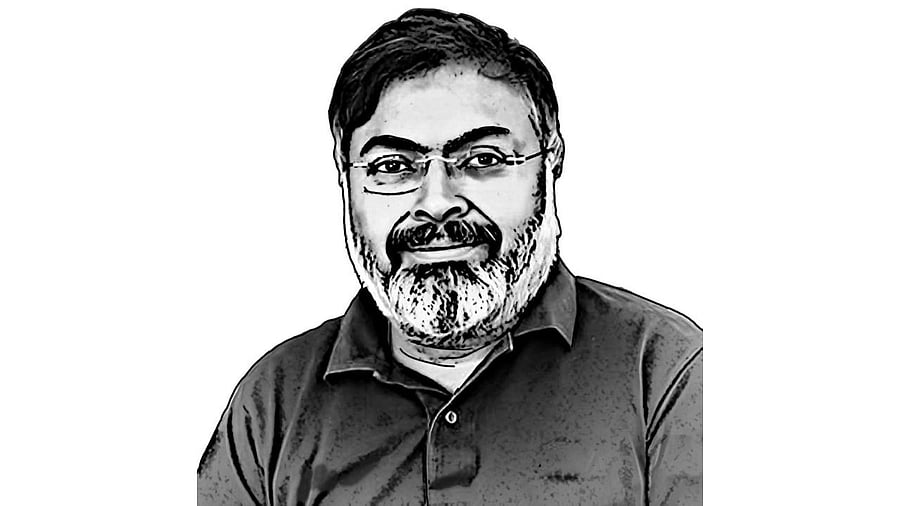
Devdutt Pattanaik works with gods and demons who churn nectar from the ocean of Indian, Chinese, Islamic, Christian, even secular mythologies
Credit: Special Arrangement
No one can make sense of India without appreciating caste. Caste has been seen as the primary tool of oppression that gave rise to dehumanising practices like untouchability. That is why ‘annihilating caste’ has been seen as a humanitarian goal in India. Despite a long history of violence, and oppression, no one speaks of ‘annihilating religion’.
Since caste is presented as a Hindu idea, rather than Indian idea, it does seem to many that Hinduism is being targeted by India’s anti-caste forces. Sanatanis insist Hinduism is Sanatan Dharma, the eternal faith. So by logic, caste is eternal, and central to Hinduism. Annihilating caste then becomes equal to annihilating Sanatan Dharma. This reeks of Hinduphobia, a word invented by American Hindus, to indicate a pathological hatred of all things Brahmin.
Politicians in the South who oppose the Hindutva-Hindification movement use the word Sanatan Dharma when they speak of caste. In doing so, they deflect all attention from the casteism prevalent in other religions of India. Even the Pope has referred to casteism seen amongst Indian Christian communities. In recent election rallies, elite Muslims were forced to accept the hidden plight of the Pasmanda Muslims, marginalised communities who cannot trace family connections to Persian and Arabian migrants. In matrimonial websites, caste is clearly a filter, no matter what your religion.
You cannot escape caste in India, by getting better jobs, by rejecting your surname or by enforcing policy decisions. The Indian word for caste is jaat and it is popularly defined as ‘that which never goes away’ (jo jaati nahin). So, despite efforts to annihilate it, it continues to flourish, manifesting as car stickers in hinterland India, and unspoken recruitment practices of Indian migrants across American tech companies.
A study of caste mythologies reveals that every caste in India – and there are over 2,000 of them – sees itself as the central identity, even more than language and class and religion. It is used to acquire resources and local respect. It is always used to position themselves above some groups. There are hierarchies within hierarchies. Different types of Brahmins. Different types of Dalits. Even the ‘lowest’ communities tell stories of how their ancestors were once royalty who were tricked by brothers into doing ‘low’ jobs and so declared ‘untouchable’. The community aspiration is not to end caste, but to reclaim their due – justice is being restored to the ‘high’ position they deserve. This subjective understanding of caste is rarely discussed in academic circles. If you say anything that sounds like you are justifying caste, you are immediately labelled with the usual invectives – elite, privileged, Brahmanical, patriarch. Scholarship is thus gagged.
Trans-activists invented wokeism to ‘annihilate gender’ in order to end patriarchy. They argued that sex is biological but gender is a social construct, and we can choose to be men or women or non-binary. Many judges in US Supreme Courts currently refuse to define womanhood. Sport organisations deny a female athlete a medal if she is 100 g overweight but not if she has male chromosomes. But when it comes to religion, people are more wary.
Marx called religion the opium of the people. But this addiction is respected even by woke activists who dare not speak about annihilating Islam (for fear of being labelled Islamophobic) or Judaism (for fear of being labelled anti-Semitic). Those who speak for the oppressed people of Palestine, or Kashmir, never raise their voice against institutionalised homophobia of Muslim nations. No one speaks of oppressive practices of the Catholic Church in Africa where gays and lesbians continue to be treated as criminals, and women are denied rights to abort unwanted fetuses. Clearly, some social constructs are tolerated, while others are not.
Social constructs, like numbers, do not exist in nature. But they help humans make sense of the world around us. Animals form herds, hives, packs, to increase their chances of survival. Humans form bands, tribes, clans, castes, communities, nations, for the very same reason. Every group has its own myth to construct an identity that allows members to differentiate themselves from outsiders. Jewish myth speaks of Chosen People and Promised Land, a narrative that shapes the violence of West Asia. The Purusha-sukta hymn of Rig Veda is chanted by Brahmins in every temple to remind Brahmins of their supreme position in any society. Reject the myth and you reject the socially constructed discrimination propped up by the story.
We are told that we must reject the caste myth, even the gender myth, but not the religious myth. Why? Rationally speaking, all myths are absurd, stories that can be discarded. But a world without stories, is a world of technocracy, where neither people nor the earth are sacred. They exist only for consumption.